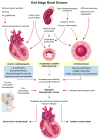Cardiovascular impact in patients undergoing maintenance hemodialysis: Clinical management considerations
- PMID: 28108129
- PMCID: PMC5316356
- DOI: 10.1016/j.ijcard.2017.01.015
Cardiovascular impact in patients undergoing maintenance hemodialysis: Clinical management considerations
Abstract
Patients undergoing maintenance hemodialysis develop both structural and functional cardiovascular abnormalities. Despite improvement of dialysis technology, cardiovascular mortality of this population remains high. The pathophysiological mechanisms of these changes are complex and not well understood. It has been postulated that several non-traditional, uremic-related risk factors, especially the long-term uremic state, which may affect the cardiovascular system. There are many cardiovascular changes that occur in chronic kidney disease including left ventricular hypertrophy, myocardial fibrosis, microvascular disease, accelerated atherosclerosis and arteriosclerosis. These structural and functional changes in patients receiving chronic dialysis make them more susceptible to myocardial ischemia. Hemodialysis itself may adversely affect the cardiovascular system due to non-physiologic fluid removal, leading to hemodynamic instability and initiation of systemic inflammation. In the past decade there has been growing awareness that pathophysiological mechanisms cause cardiovascular dysfunction in patients on chronic dialysis, and there are now pharmacological and non-pharmacological therapies that may improve the poor quality of life and high mortality rate that these patients experience.
Keywords: Cardiovascular complications; End stage renal disease; Hemodialysis.
Copyright © 2017 Elsevier B.V. All rights reserved.
Conflict of interest statement
Figures
References
-
- Collins AJ, Foley RN, Chavers B, Gilbertson D, Herzog C, Ishani A, et al. US Renal Data System 2013 Annual Data Report. Am J Kidney Dis. 2014;63:A7. - PubMed
-
- Eknoyan G, Beck GJ, Cheung AK, Daugirdas JT, Greene T, Kusek JW, et al. Effect of dialysis dose and membrane flux in maintenance hemodialysis. N Engl J Med. 2002;347:2010–9. - PubMed
-
- de Jager DJ, Grootendorst DC, Jager KJ, van Dijk PC, Tomas LM, Ansell D, et al. Cardiovascular and noncardiovascular mortality among patients starting dialysis. JAMA. 2009;302:1782–9. - PubMed
-
- Foley RN, Parfrey PS, Sarnak MJ. Clinical epidemiology of cardiovascular disease in chronic renal disease. Am J Kidney Dis. 1998;32:S112–9. - PubMed
-
- Kalantar-Zadeh K, Block G, Humphreys MH, Kopple JD. Reverse epidemiology of cardiovascular risk factors in maintenance dialysis patients. Kidney Int. 2003;63:793–808. - PubMed
Publication types
MeSH terms
Grants and funding
LinkOut - more resources
Full Text Sources
Other Literature Sources
Medical
Miscellaneous


